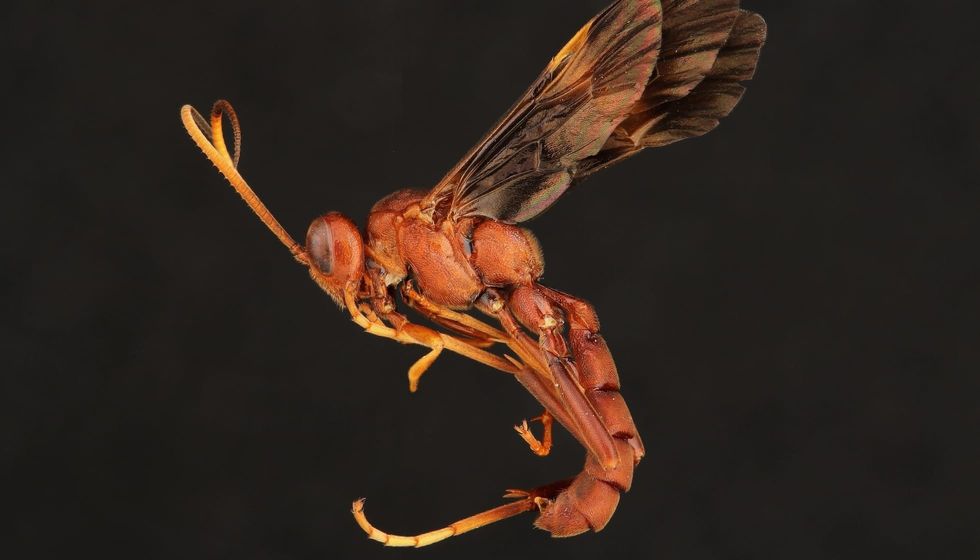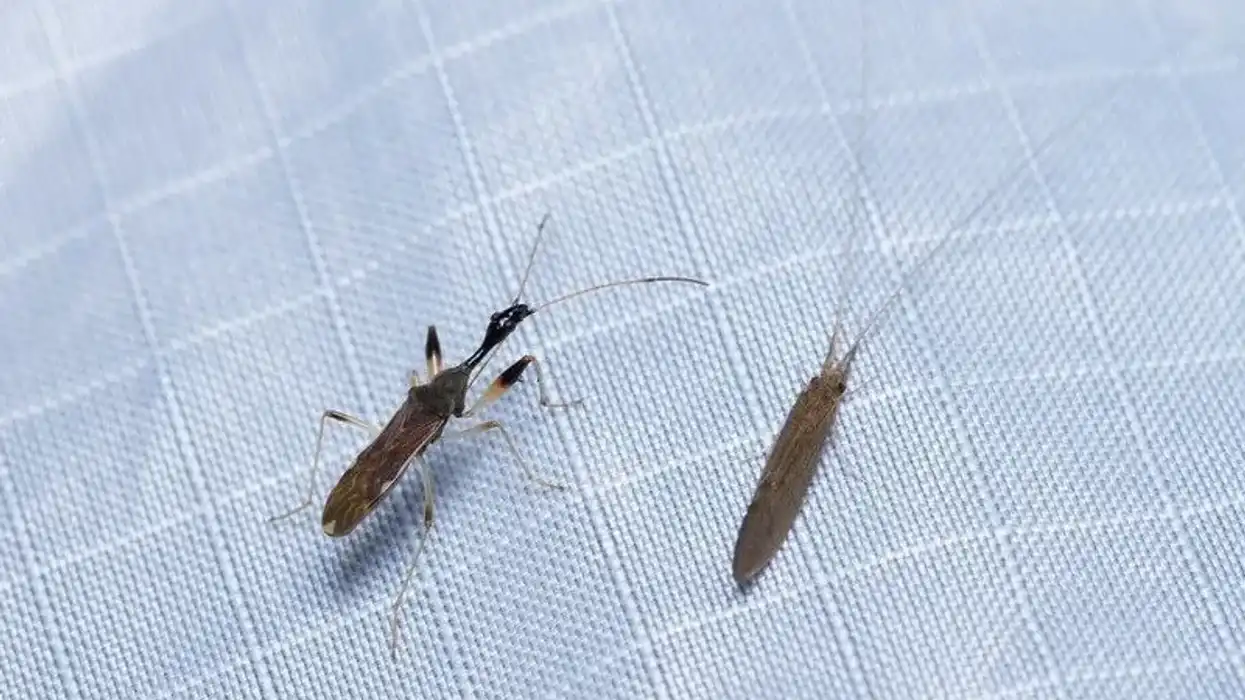Giant Ichneumon wasps, one of the largest parasitic wasps, are one of the few economically beneficial insects you could ever find! Want to know why? Well, these wasps, although being parasitic, also help kill other pests around them. Sounds helpful, right?
But how will you identify them is the question. You would find them in tropical regions, specifically the woody areas. The female's impressive five-inch long ovipositor could also help you spot them!
What distinguishes them from their other cousin wasps, if that's what you're wondering, is their slender body and longer antennae which is why they are rightly called the 'Giant' Ichneumon wasps. The name 'Ichneumon' has a Greek origin meaning 'tracker' and 'footprint.'
Keep scrolling down to continue reading about the Giant Ichneumon wasps, and do not restrict yourself to just this one tiny insect, do give our articles on the cuckoo wasp and great black wasp a read as well!
Giant Ichneumon Wasp Interesting Facts
What type of animal is a giant ichneumon wasp?
The Giant Ichneumon wasp is a parasitoid wasp that acts as a regulator for pests by making them their hosts.
What class of animal does a giant ichneumon wasp belong to?
Giant Ichneumon wasp typically belongs to the group of Horntail wasp in the Insecta class.
How many giant ichneumon wasps are there in the world?
Like their name, the Giant Ichneumon wasp is present in giant numbers worldwide! With 60,000-100,000 species spread across the globe, these insects are far from being rare like other species of insects.
Where does a giant ichneumon wasp live?
The go-to Giant Ichneumon wasp location is the woody regions of North America.
What is a giant ichneumon wasp's habitat?
The Ichneumon wasps live in the wooded areas spread across North America, although they avoid the dry, arid, and scarcely planted areas.
Who do giant ichneumon wasps live with?
The North American Giant Ichneumon wasp, or the 'Ovipositor' as it is also called, is, in essence, a solitary animal. It is a parasitoid.
If you wonder if parasitoids and parasites are the same, you are slightly wrong. Parasitoids are an extreme version of parasites where the long ovipositor kills its host when it advances from the parasitic stage to the free-living part of its life cycle. The larvae feed on or inside another insect host species until they die.
How long does a giant ichneumon wasp live?
Naturally, the lifespan of the Giant Ichneumons would last as long as its host lasts, but it is common for the parasitoid wasps to survive up to 27 days.
How do they reproduce?
The female Ichneumon wasp mainly controls the reproduction of the Ichneumon wasp. The Ichneumon wasp uses its extremely long ovipositors to inject eggs into or on the pigeon horntail.
The ovipositors are a needle-like attachment at the tip of their abdomen used for laying eggs inside the host's body that's usually a caterpillar, pupa, or grub. The ovipositor is often longer than its entire body!
A striking fact to note here is that these species of wasps strictly require the larvae of pigeon horntail (pigeon tremex) for their egg-laying.
The pigeon horntail, or pigeon tremex as it's also called, belongs to the family of wasps and is the primary host for the female Ichneumon wasp to lay eggs and reproduce the next batch of the larva.
Burrows are often the most suited choice to make the insertion of the ovipositor easier, as egg-laying locations get destroyed by rot and fungus.
What is their conservation status?
The Ichneumons are not rare and are currently present in large numbers, so their conservation status is Least Concern as of date.
Giant Ichneumon Wasp Fun Facts
What do giant ichneumon wasps look like?
The Giant Ichneumon wasp has a thin body with a long ovipositor. These tiny insects are predominantly yellow or brownish-orange, their round-triangular heads to their shiny thorax with yellow spots, and antennae.
Their fore-wings, along with their long and slender legs, are also yellow! So next time you see an insect being mostly yellow, then you have come across an Ichneumon wasp.
How cute are they?
The wasp having roots from the family Ichneumonidae have distinctive colors like red-brown. Their stinger-like ovipositor adds to the attractive factor, so they could be called cute for the class of insects.
How do they communicate?
The insect, the Ichneumon wasp, communicates with various sensory cues such as olfactory, auditory, and vibratory. The antennae present on them have sensory organs composed of two specific hair types and plate organs that enable communication. Fascinating, isn't it?
How big is a giant ichneumon wasp?
The Ichneumons are the largest of the parasitic wasps, with a body reaching two inches long along with a long ovipositor (stinger). You could say this wasp is twice as big as a common wasp.
How fast can a giant ichneumon wasp fly?
The Giant Ichneumon wasp usually stays quiet within its hosts and does not fly much. This species of wasp Megarhyssa macrurus has wings that are long and narrow. This includes a pair of fore and hind wings that lock together during their flight. The numerous veins and cells visibly cover the Giant Ichneumon wasp's range of wings.
How much does a giant ichneumon wasp weigh?
Wasps in general weigh about 0.0032 oz (103.1 mg) only.
What are the male and female names of the species?
It is common to call the male and female species of Giant Ichneumon wasp itself, but you could differentiate between the two based on the most obvious factor, their size. The females have a large size as compared to their male counterparts.
The females also have a much longer ovipositor. Another distinguishing fact to note is the sternal plates present on the females appear divided, whereas they appear a whole on the males.
Finally, the most layman difference observed is the obvious color difference between the two. Males appear more yellow than females, along with a raised yellow spot underneath each forewing.
What would you call a baby giant ichneumon wasp?
Scientifically the baby Giant Ichneumon wasp is called larvae before it grows into a fully grown adult. They remain as larvae throughout the winter season while continuing to feed on their host. However, you could always name it whatever you want since a larva is always open to cute names!
What do they eat?
Surprisingly, the adult Giant Ichneumons don't feed much after their transformation from their larvae stage. All the adults have a typical diet, i.e.
they consume the nectar from the flowers at the most. However, the larvae are the real consumers who feed on the host until they enter the pupate stage, so you could say these insects feed the most when they are in their larva stage.
Are they poisonous?
Here's the good news! These wasps from North America are completely harmless to us humans. Although, according to studies, the Giant Ichneumon wasp sting could be painful. However, one family of harmful insects is the horntail wasp. Once the female lays eggs after detecting the presence of pigeon horntail, the emerging larva kills the host horntail wasp.
Would they make a good pet?
If you want a harmless, tiny, good, no-maintenance pet who could also be put to some use in your garden, then you should consider the Giant Ichneumon wasp! Firstly these parasitoids find no joy in interacting with humans, so you are safe!
Second, they would also help you keep your insect pests under control by killing their larvae before they transform into adults and produce more pests, so isn't it a win-win situation for both?
Did you know...
Although belonging to the wasp family, the Giant Ichneumon wasp does not sting you. However, if you mishandle or mistreat them, they would probably sting you using their stinger, the ovipositor, as an act of defense. A mere allergic reaction the same could be the aftermath of their sting.
Another interesting fact is that all Giant Ichneumon wasps come from North America. So if you are living there, then look out for the woody regions around your home; you might find these tiny insects giving you company! If, however, you want to get rid of them, you can always wasp destroyer spray.
How do giant ichneumon wasps lay their eggs?
This species of the order Hymenoptera are real opportunists because they never build nests for their eggs or young. Instead, they lay eggs into their hosts, such as the Tremex columba, commonly known as the pigeon horntail. The interesting fact is how the females locate the host for laying eggs. They do so by locating the host's food source.
Once they locate the host, the female then lays the eggs in or on its body. Sometimes this process could get arduous, so the female wasp then uses her five-inch long ovipositor to drill a hole in the wood, find the host, and lay her eggs.
What do giant ichneumon wasps do when resting?
We all like to rest, right? But ever wondered what the Gian Ichneumon wasp likes doing when it rests? The females curl up the ovipositor that they have beneath their abdomen over their bodies. Peculiar animals, aren't they?
Here at Kidadl, we have carefully created lots of interesting family-friendly animal facts for everyone to discover! Learn more about some other arthropods including the red paper wasp or mud dauber wasp.
You can even occupy yourself at home by drawing one on our great ichneumon wasp coloring pages.









